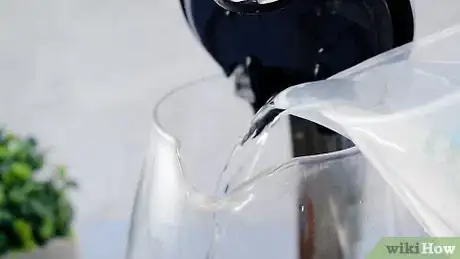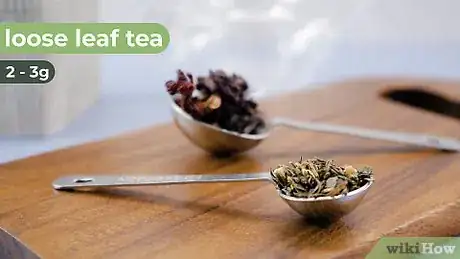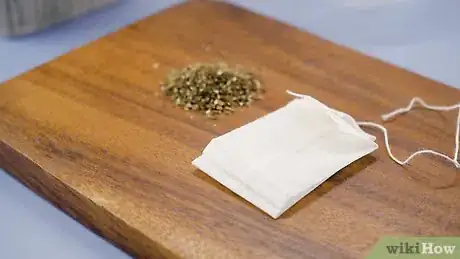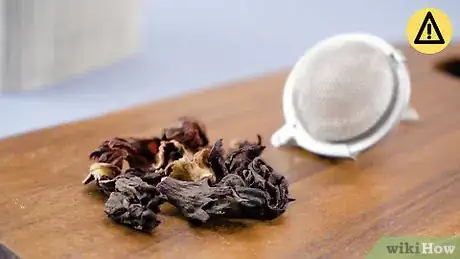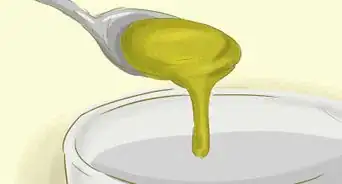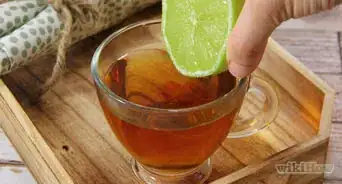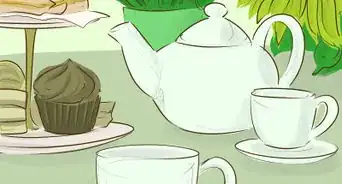This article was co-authored by wikiHow Staff. Our trained team of editors and researchers validate articles for accuracy and comprehensiveness. wikiHow's Content Management Team carefully monitors the work from our editorial staff to ensure that each article is backed by trusted research and meets our high quality standards.
The wikiHow Video Team also followed the article's instructions and verified that they work.
This article has been viewed 366,647 times.
Learn more...
All you really need to prepare loose leaf tea is hot water, the leaves themselves, and a tea strainer. However, each type of tea requires slightly different steeping techniques. For the best cup, follow the recommended measurements, water temperature, and steeping time outlined on the package of tea. Experiment with different quantities of tea or steeping durations. Finally, add in your favorite sweetener or milk for a soothing cup of tea that really hits the spot.
Steps
Mastering Tea-Steeping Basics
-
1Pour fresh, cold water into a saucepan or kettle. Don’t use distilled or previously boiled water as it may negatively affect the taste of your tea. Instead, start with fresh, cool water from the tap.[1] Use an electric kettle, stovetop kettle, or a saucepan to warm up the water.
- If your local water is especially hard (i.e. high in mineral content), consider using bottled water for a more pleasant taste.
-
2Heat the water until it reaches 160 to 212 °F (71 to 100 °C). Remove the water from its heat source once it begins to steam, simmer, or reach a rolling boil. Depending on the tea variety you’re preparing, you may need it to be slightly warmer or cooler to bring out the best flavors in the leaves. Use an instant-read thermometer to get the most accurate temperature.
- If you prefer, you can boil the water and allow it to cool down to the correct temperature before adding it to the tea leaves.[2]
- In general, white and green teas can be brewed at a lower temperature with the water just starting to steam, while oolong tea is typically best prepared at a moderate simmering temperature. Black and Puerh teas can withstand a higher temperature when the water hits a rolling boil.[3]
Advertisement -
3Weight out 2 to 3 grams of loose leaf tea for every 6 fl oz (180 mL) of water. Since tea leaves come in different shapes and sizes, it’s best to measure out your tea by weight (i.e. grams) rather than by volume.[4] But if you do measure by volume, start with roughly 1 teaspoon for smaller leaves and about 1 tablespoon for larger leaves. Spoon out your desired amount of tea into a tea strainer or teapot, depending on how you plan to steep it.
- A teacup holds about 6 fl oz (180 mL) of water, but since most coffee mugs hold about 10 to 12 fl oz (300 to 350 mL) of water, you may need to double the amount of loose leaf tea you use in a larger mug.
- The amount of tea you decide to use is completely a matter of taste. Steep more or less to see which flavor you prefer.[5]
-
4Steep the tea in hot water for 3 to 5 minutes. Pour the hot water directly over the tea leaves and allow the flavors to seep out for a few minutes. Different tea varieties require slightly different steeping times, so be sure to follow the instructions on the packaging. If you’re not sure how long to steep the leaves, start with 3 minutes for your first cup. Then add 30 more seconds for each subsequent cup until you find the perfect taste.
- Generally speaking, green and oolong teas can be steeped for about 3 minutes, white tea for 4 minutes, and black and Puerh teas for 5 minutes.[6]
- Avoid steeping tea longer than 5 minutes; it will only taste bitter. If you want a stronger cup, just add more tea leaves and keep the timing the same.
- Since herbal teas don’t contain any actual tea leaves, they can often be left to steep longer without taking on a bitter flavor.[7]
-
5Remove the tea leaves from the water once they’ve steeped. How you do this will depend on the type of strainer you’re using. Basket-style strainers, metal or silicone infusers, and filter bags can be lifted out of your teapot or cup to stop the infusion. Place the strainer on a spoon rest or saucer to catch the drips from the soggy tea leaves.
- If you steeped the tea directly in the teapot, hold a strainer over your teacup to catch the damp leaves as you pour out the tea.
- Discard the used tea leaves while they’re damp, or wait until they’ve dried out to more easily tip them out of the strainer.
Using Tea Strainers
-
1Place the tea leaves directly into a tea strainer for easy cleanup. Place a basket-style tea strainer into a cup or teapot first. Measure out the loose leaf tea into the strainer and pour the hot water directly over it. Make sure you completely cover the tea leaves with water so that they steep properly.[8]
- After a period of 3 to 5 minutes, simply remove the strainer and the damp tea leaves.
-
2Choose a disposable filter bag for fine, powdery teas. Buy a packet of disposable tea filter bags from a tea shop or grocery store. Use one when you’re preparing especially fine tea which tends to slip through mesh strainers easily. Keep the bag upright with the opening well above the water level so the tea leaves don’t float out.
- You can also use a filter bag if you just want to make 1 cup at a time with easy cleanup.
-
3Use a mesh, basket-style tea strainer for larger tea leaves. Most loose leaf teas can be successfully steeped in these types of strainers. Choose one that fits correctly within the opening of the cup or teapot you’ll be using; it shouldn’t shift around or sink into the vessel, otherwise the tea leaves will escape.[9]
- Try a travel tea mug with a built-in basket strainer if you’ll be on the go. Just remember to remove the tea after it’s steeped for 3 to 5 minutes.
- While a short or rounded basket strainer may work for a single cup, use a deeper basket to steep loose leaf tea in a deep mug or teapot.
-
4Avoid using tea balls or infusers for large or fine leaves. Metal tea balls and silicone tea strainers are popular since they come in playful designs, but keep in mind the limited practicality of these tools. Refrain from using them for large-leafed tea as they won’t leave much room for the leaves to unfurl as they become hydrated. Additionally, avoid using a tea ball or infuser for fine, powdery teas as the tea leaves may slip through the holes easily.
- If you’re steeping medium-sized tea leaves in small quantities of water, a tea ball or infuser might not pose any problems.
- Hinged tea balls are difficult to fill and the mechanisms can be tricky to open and close, especially when the metal is hot.[10]
-
5Leave plenty of room for the tea leaves to expand in the strainer. Loose leaf tea leaves can grow up to 5 times their original size once you hydrate them with hot water. For this reason, aim to leave plenty of space in the tea strainer or filter bag. Don’t overfill it with too much tea.[11]
- A mesh basket-style strainer will allow the tea to expand, while a tea ball may compress the leaves.[12]
- A little extra space will allow the water to flow around the tea leaves so you’ll have a better result.
-
6Strain the tea after it steeps in the teapot if you prefer. This is a useful technique if you don’t have a tea strainer that fits correctly in your teapot. Instead of placing the leaves into a strainer, what you can do is measure out the tea leaves and drop them directly into your teapot. After the leaves have steeped, hold a tea strainer over your cup. Carefully pour the liquid into the cup and you’ll see the strainer catch the leaves.[13]
- Since there will still be leaves sitting in the teapot, the tea will grow more bitter as it continues steeping.
Community Q&A
-
QuestionCan pecan leaves be used as a tea?
 Community AnswerI suppose, as long as they are safe to eat (grown without pesticides and cleaned first), but I'm not too sure that would taste good.
Community AnswerI suppose, as long as they are safe to eat (grown without pesticides and cleaned first), but I'm not too sure that would taste good. -
QuestionHow do I steep boysenberry tea?
 Community AnswerFor most herbal and fruit teas, it is recommended you leave the tea bag in for 5 minutes, but if you wanted to keep the tea bag in your cup, herbal teas are great for that.
Community AnswerFor most herbal and fruit teas, it is recommended you leave the tea bag in for 5 minutes, but if you wanted to keep the tea bag in your cup, herbal teas are great for that.
wikiHow Video: How to Brew Loose Leaf Tea
Things You'll Need
- Kettle or saucepan
- Cool, fresh water
- Teapot
- Teacup
- Tea strainer
- Loose leaf tea
- Measuring scale or spoon
References
- ↑ https://www.thekitchn.com/how-to-brew-black-tea-cooking-lessons-from-the-kitchn-201670
- ↑ https://www.thekitchn.com/how-to-brew-loose-leaf-green-t-139441
- ↑ https://www.ohhowcivilized.com/tea-brewing-guide-beginners/
- ↑ https://www.thekitchn.com/how-to-brew-black-tea-cooking-lessons-from-the-kitchn-201670
- ↑ http://mentalfloss.com/article/536417/how-long-steep-your-tea-according-science
- ↑ https://www.ohhowcivilized.com/tea-brewing-guide-beginners/
- ↑ http://mentalfloss.com/article/536417/how-long-steep-your-tea-according-science
- ↑ https://www.thekitchn.com/how-to-brew-black-tea-cooking-lessons-from-the-kitchn-201670
- ↑ https://thewirecutter.com/reviews/best-tea-steeper/
- ↑ https://www.myrecipes.com/extracrispy/tea-balls-suck
- ↑ https://thewirecutter.com/reviews/best-tea-steeper/
- ↑ https://www.ohhowcivilized.com/tea-brewing-guide-beginners/
- ↑ https://www.thekitchn.com/how-to-brew-black-tea-cooking-lessons-from-the-kitchn-201670
- ↑ https://www.thekitchn.com/how-to-brew-black-tea-cooking-lessons-from-the-kitchn-201670
- ↑ https://www.thekitchn.com/how-to-brew-loose-leaf-green-t-139441
About This Article
To brew loose leaf tea, start by measuring out 1 teaspoon of loose tea leaves per cup of tea you're making. Then, put the leaves into the cups you're going to be drinking out of. Next, bring a pot of water to a boil and then pour the boiling water over the tea leaves in the cups. Let the tea steep for 3-5 minutes, remove the tea leaves, and enjoy! If you want to learn the different steeping times depending on the tea you have, keep reading!
